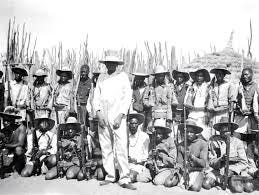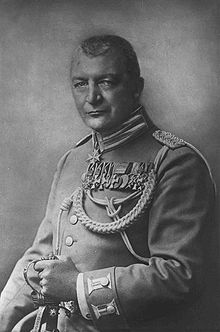A National Monument erected in remembrance of King Mandume at Oihole, Namacunde-Cunene in Angola. The article here presents some ra...
Who's Mandume?

King Mandume and his subjects at Oukwanyama Royal Palance in Oihole circa 1916.
According to many accounts, Nekoto, King Weyulu and King Nande’s aunt, hid him in an anteater hole. When his aunt came to feed him one night, Mandume was already at the entrance and was burned on the left side of his face, which left a small scar where he usually put (Okakatha) to conceal the scar. As he grew too big to be kept in the hole, Nekoto took him to his aunt Hipondoka Nyanya, who hid him again in her kraal (the homestead). Eventually, Mandume was whisked to Oshiteve for safety, which was situated further northwest of Oukwanyama, where he remained until he was about ten years old. The historian Hinananye Nehova and now Namibian politician has commented that Mandume lived in different parts of Oukwanyama, particularly Oiheke, located in southwest Oukwanyama.
Aunt Nekoto took him into her kraal again, where he remained most of his time as a youth under her protection. After Nande’s death, Mandume was elevated and became king of the Kwanyamas in 1911. According to Wulfhorst, Mandume as a young boy, he grew up with a great vengeance and unfriendly in demeanour'. Mandume seems to have grown up with a number of grudges. Mandume vowed to remain unmarried until his reforms were effective, which he equated it with bringing peace to Oukwanyama.
At the time when he became a king, the country was already divided between two European powers, Portugal in north and Germany in the south. Kwanyama territory was also still under pressure from the colonial powers that were operating in the region. Madume saw the real culmination and unprecedentedly upheavals unfolding in his eyes. The Portuguese were the immediate threat came from Angola, who already claimed the largest, northern part of Kwanyama territory by the default agreement made via the Scramble of Africa of 1884 between the colonial masters.
Mandume inherited a kingdom marked by significant social disorders, which his predecessors had left unchecked and he undertook a radical action to improve the situation by instituting progressive Agrianian reforms. He is represented in both written and oral accounts as having from the first a coherent, integrated vision of necessary internal change for Oukwanyama in general. First, he announced the decrees that forbid fruit trees from being harvested while unmatured/ripe. Second, he prohibited random shooting within the kingdom, as guns were being popular owned and fired unnecessarily in the country, resulting in deaths; he advised that ammunition should be spared for the war against the white men.
One of Mandume's greatest concerns was the fact that the Portuguese were recruiting commoners to replace the hereditary bloodline of chiefs with their own puppet headmen who were loyal to them, thus weakening the control of the traditional leaders. Another of Mandume's concerns was the spreading influence of the church of Rhenish and Lutheran missionaries, which he regarded as agents of the penetration by colonial powers. According to Oukwamaya history, he burned down a Roman Catholic mission stations at Iipanda and Ondjiva and subsequently expelled them out. He also put an end to the Portuguese illegally taxes in the part of his territory that they controlled: Actions such as these made him unpopular with the colonial authorities, who rightly perceived Mandume as an obstacle to their plans for hegemony over the parts of Owamboland that they claimed.
Hayes Patricia in the Order of Chaos states, ''Once these preliminary measures was in place, Mandume began to tackle rival power bases, by curbing the powers and abuses of senior headmen''. This is because the senior headmen were accused of forcing the “naturally rich” people of Oukwanyama, in order to appropriate their crops and cattle. Therefore, Mandume prohibited cattle raiding both inside Oukwanyama and in the neighbouring countries. This was because his generals carried out raids and wars by their own initiative on countries with whom they enjoyed good relations. Mandume also decreed that foreigners passing through Oukwanyama should not be attacked, because some of them might prove to be good trading connections.
When the First World War broke out in 1914, the entire situation has changed completely. This following the clashes between Portuguese with German force at the border post of Naulila (Battle of Naulila) on 19 October 1914 that led the victory for the German imperial forces and the withdrew of the Portuguese from southern Angola. King Mandume foresee that soon Germans will invade Oukwanyama's kingdom, so he anticipated to assert Kwanyama regional hegemony throughout Ovambo trying to form the alliance.

After three days of heavy fighting, South Africans and Protugequse converged at a certain place called Omongwa where Mandume’s main force was waiting for them. A massive battle ensued between the Portuguese contingents commanded by General Antonio Pereira D’Eça, an artillery General of the Portuguese Army, a colonial administrator and Minister of War who was regarded as a hero that crushed the Shangaans and Tsongas at Mapulanguene in Mozambique in 1897 and capitulated a quick victory over the Germans at the battlefield of Naulila, indeed the Antonio was a man with rare characters that strike like a storm thunder, however he was unmatchable to Mandume's strategical ingenuity.
Despite less supply and traitors within them, Kwanyamas fought bravery but their casualties were enormous, and after three days in a constant fighting they were forced to acknowledge a conditional defeat. Mandume consequently then moved his capital from Ondjiva across the border into Oihole (in present-day Namibia), where he sought protection from the British South Africans by signing a protection treaty in September 1915 with Colonel Pritchard, the Union Government Officer at the time. The war against the Portuguese continued throughout 1916 until the Portuguese suffered a serious humiliating defeat at a place called Oluvanda la Luuli. After this battle, the Portuguese called on the British-South African army in Windhoek to come to their aid. Throughout his reign, Mandume resisted both Portuguese and British-South African colonial rule from two directions.
we shall fight until the last bullet remains spent and we shall die as free men and never as slaves.Finally, during February 1917, a strong South African force that took over after Germany defeated moved against Mandume, guided by local informers who exposed the guerrilla-like traps that Mandume he had laid for them. When the force approached Mandume at his homestead early morning, he had less than 300 men with him unprepared. There was a furious exchange of gunfire until the Maxim guns, cannons and heavy gunstones of the European powers combined opened fire on unprepared belligerent warriors, wounding and killing many soldiers of Mandume and later settling the conflict decisively.
Oral informants noted that long before the Portuguese and British-South African colonial forces invaded Oukwanyama from the south and north, Mandume and his commanders, Shikololo sha Hangula, Shipahu sha Weyulu, and Uhela wa Haishi, had vowed never to surrender to the enemy, stating “we shall die as free men and never as slaves.” Mandume was decapitated by the British-South African troops and his head taken to Windhoek. After the battle of Oihole, the Oukwanyama kingdom was shared between the Portuguese and British-South Africa and the royal family went into hiding. Mandume was only succeeded by King Mwetupunga Cornelius Shelungu in 1997, who built his palace at Omhedi (in present-day Namibia).
Over Views
To the Namibians and many Angolans Mandume regarded as an unblemished hero of the anti-colonial resistance. To Portuguese and South African colonisers, on the other hand, he was an over-powerful, despotic and defiant king who refused to allow them control over his actions. South African sources, in particular, run the gamut of caution with both mixes of sympathy, frustration, hostility and admiration toward him. All these perceptions focus on resistance. The Mandume literature generally does this for two obvious reasons: the density of colonial records on the subject and its importance to Namibian national liberation and Angola, where he named after the most popular education institution, University of Mandume ya Ndemufayo.Within one year of Mandume's assumption of power, the Christian community in Oukwanyama had come to feel very insecure. Many families fled to Ondonga where they were majority converts and they were met with greater tolerance. Mission sources, especially Rhenish, suggested that Mandume was impetuous, restless and highly autocratic, reluctant to accept criticism, whether from headmen, elders or paternalistic German missionaries. 'He was intelligent and thoughtful,' wrote Wulfhorst, but very willful.
As according to Vilho Kaulinge testimony, the grandson and a direct descendant of King Mweshipandeka of Oukwanyama, him as a youth he lived and served in close proximity to Mandume. After king Mandume death, he converted to Christianity and became a Lutheran pastor. He testified that Mandume re-enforced the obligations for women to work in the fields set up by the royal authority, which had been neglected for years during the previous reign, the order compelled all Christian congregations at Ondjiva and elsewhere where black young women recruited in the sisterhood services, the church was obliged to undertake a disproportionately large share of this task to free the woman work in Omahangu fields.
Madume's reform clearly has put the value on agricultural work instead of church service. His main objective was to drive his kingdom towards an 'agrarian prosperity' and become a self-sufficiency society that dwells outside the capitalist economy of the west.
Oukwanyama's Aristocal Bloodlines
1. Kambungu ka Muheya (Onambambi-Onehula) around 16002. Shitenhu (Oshiteve) around 1600
3. Kawengeko (Ondjiva) around 1600
4. Mushindi ua Kanhene Uandja (Ondjiva) around 1600
5. Kavonga ka Haindongo (Ondjiva) around 1600
6. Heita ya Muvale (Ondjiva) around 1690
7. Hautolonde ya Uandja (Ondjiva) 1755-1760
8. Mutota wa Haipiya (Ondjiva) 1760-1766
9. Shimbilinga sha Nailambi (Ondjiva) 1766-1806
10. Haihambo ya Mukwanhuli (Ondjiva) 1806-1807
11. Hamangulu Nahambo ya Naivala (Ondjiva) 1807-1811
12. Haimbili ya Haufiku (Ondjiva) 1811-1858
13. Haikukutu yaShinangolo (Ondjiva) 1858-1859
14. Sheefeni sha Hamukuyu (Ondjiva) 1859-1862
15. Mweshipandeka ya Shaningika (Ondjiva) 1862-1882
16. Namhadi ya Mweihanyeka (Ondjiva) 1882-1884
17. Ueyulu ya Hedimbi (Ondjiva) 1884-1904
18. Nande ya Hedimbi (Omukumbwaimbi) 1904-1911
19. Mandume ya Ndemufayo (Ondjiva) 1911-1917
20. Cornelius Mwetupunga Shelungu (Omhedi) 1998-2005
21. Martha Mwadinomho ya Kristian ya Nelumbu (Omhedi) 2005 –
Other Sources
(1) Hayes, Patricia. “Order Out of Chaos: Mandume Ya Ndemufayo and Oral History.”
(3) Southern African Studies 19, no. 1 (March 1993): 89–113.
(2) Vilho Kaulinge (Healing the Land: History of Kwanyama )
(4) Emmanuel K.; Akyeampong and Henry Louis Gates Jr: Oxford University (African Bibliography)
(5) Reverend Apollus Kaulinge; David Haufiku; Reverend Phillipus Nakanwe; Godfrey Nangonya; Ms Emilia Nhinda and Ana Maria De Oliveira (Mandume ya Ndemufayo’s memorials in Namibia and Angola)(6) National Archives of Namibia
(7)Arquivo Histórico Nacional (Angola)
(8) Napandulwe T. Shiweda (Dissertation: University of Western Cape)

.webp)





